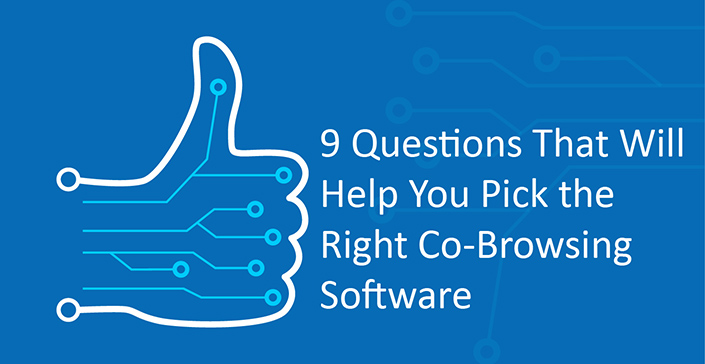Providing intuitive and empathetic customer service has been a key priority for companies. For organizations today, in this era of Omni-channel online retail, ensuring that their customers experience customer service that respond to their need in real time and provide prompt solutions even remotely is a critical challenge.
Co-browsing software has been a vital tool that can provide customer service agents with the ability to view the customer’s screen and gain in-depth real-time understanding of the customer’s experience while browsing a website. This facility gives a visual understanding of the problem, allowing agents to sort out the issue the very first time it arises, leading to higher customer satisfaction and ultimately higher sales.
Adoption of this innovation was low during early years but has increased with several technological advances. Companies seeking to deploy the tool must however be careful to identify the right solution.
Here are nine questions that every company must ask before giving the greenlight:
- Does the program require any special download or installation on part of the customer?
Several websites having online tools require customers to change their setting or download special supporting software like JAVA or a full program to access services like screen sharing. This can worry customers and create a feeling of suspicion which will put them off the idea of cobrowsing. A cobrowser that is inbuilt within the website requiring no additional action on the customer’s end is the right solution and gives you much more than just screen sharing!
- Will sensitive information be revealed?
Online transactions have a reputation being open to scams and fraud. When a program exposes confidential information it can be dangerous. Co-browsing Software must retain the confidential information at the host machine and not transmit it to even a server. This level of privacy and security will reassure customer that no third-party can ever see their information.
- Is sharing of customer information unrestricted?
In the older versions of the cobrowser, the entire customer information embedded in the host or customer end is sent as code to other participants or the server. This means that the information can be hacked or accessed by others, which must be avoided.
- Is the flow of information direct between the parties?
When the customer or the host and the guest participants cobrowser using the latest version, information is exchanged via a narrowcast broker which limits the information sent to restricted images of the hosts’ webpage. This ensures that code is not directly shared which prevents any opportunity for insertion of malicious software.
- Can the guest view all webpages or the desktop on the host’s device?
Software that are unable to restrict viewing of the Host device to the concerned webpage alone can be security hazard and be off-putting for customers. It infringes on their privacy and can cause impact the customer’s online security. Earlier versions of cobrowsing software were based call center software that gave full access and visibility but the latest version avoids this.
- Does it allow taking over control of host computer.
Co-browsing software that offers the feature of gaining full control of host device is useful in solving tech support issues but this can be a problem when it’s a simple interaction situation. It arouses doubt in minds of the customer and creates a fear of losing control. Latest co-browsers avoid this with an inbuilt mechanism to block access but allow viewing.
7.Are the number of guest viewers limited?
In several circumstances it might be useful to have more than two participants. Newer versions of the co- browser allow several geographically spread viewers to participate making it a powerful tool.
- Is the solution hosted on a shared platform?
Dedicated solutions are necessary to achieve full control over the data management and maintenance of the software. Several SaaS services use shared tenancy as a measure to reduce cost and offer speed of service, but this can hamper security.
- Is the solution a feature-rich comprehensive tool?
Instead of having a disparate set of tools, the latest version of a real-time engagement platform is an all-in-one-bundle that gives a seamless customer connectivity capability to customer service agents. It spans live chat, video chat along with cobrowsing supported with online document sharing and multi-channel support. This ensures that the customers get an interactive and engaging experience on a website.

0 Comments
Leave A Comment